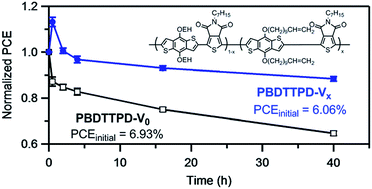Long-term thermally stable organic solar cells based on cross-linkable donor–acceptor conjugated polymers†
Abstract
The real-life application of polymer solar cells (PSCs) requires both a high power conversion efficiency (PCE) and a long enough lifetime. In order to avoid microstructure evolution and enhance device thermal stability, various different amounts of terminal vinyl moieties have been integrated into the side chains of poly(benzo[1,2-b:4,5-b′]dithiophene-alt-thieno[3,4-c]pyrrole-4,6-dione), a previously reported high performance donor–acceptor photovoltaic polymer, to produce a series of crosslinkable polymers named PBDTTPD-Vx (where x is defined as the molar content of vinyl units). It has been found that the larger the vinyl content the polymer contains, the larger the amount of polymer remaining on the substrate after thermal crosslinking and solvent washing. However, the optimized PSC device based on such a polymer and [6,6]-phenyl-C71-butyric acid methyl ester (PC71BM) displayed a decreased efficiency. These studies have discovered that a vinyl content as small as 2.5% is enough for this family of crosslinkable polymers to achieve effective crosslinking, while at the same time maintaining their high photovoltaic performance. The optimized PBDTTPD-V0.025/PC71BM device showed a power conversion efficiency (PCE) of 6.06% after thermal crosslinking, which represents the highest recorded efficiency among PSC devices with crosslinked active layers. Furthermore, this crosslinked device successfully retained 91% of its initial PCE after thermal treatment at 150 °C for 40 h, which was much better than the non-crosslinkable PBDTTPD-V0/PC71BM cell.


 Please wait while we load your content...
Please wait while we load your content...